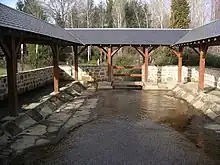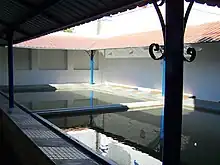Lavoir
A lavoir (wash-house) is a public place set aside for the washing of clothes. Communal washing places were common in Europe until industrial washing was introduced, and this process in turn was replaced by domestic washing machines and by launderettes. The English word is borrowed from the French language, which also uses the expression bassin public, "public basin".

Description
_-_n._12182_-_Sanremo_-_Popolane_al_lavatojo.jpg.webp)
Lavoirs were built from the seventeenth to the early twentieth centuries. With Baron Haussmann's redesign of Paris in the 1850s, a free lavoir was established in every neighbourhood, and government grants encouraged municipalities across France to construct their own.[1] Lavoirs are more common in certain areas, such as around the Canal du Midi.[2]
Lavoirs are commonly sited on a spring or set over or beside a river. Many lavoirs are provided with roofs for shelter. With the coming of piped water supplies and modern drainage, lavoirs have been steadily falling into disuse although a number of communities have restored ancient lavoirs, some of which date back to the 10th century.
There are also bateaux-lavoirs ("laundry boats") in some towns on the banks of large rivers such as Paris and Lyon.
Gallery
 A lavoir at Groix
A lavoir at Groix Lavoir at Noyers-sur-Serein
Lavoir at Noyers-sur-Serein Lavoir at Gunstett
Lavoir at Gunstett Laundry boat at Laval
Laundry boat at Laval Laundry boat in Haute-Garonne, 1901
Laundry boat in Haute-Garonne, 1901_lavadero_p%C3%BAblico_(RPS_27-09-2014).png.webp)

 Public washbasins at San Miguel de Allende (México)
Public washbasins at San Miguel de Allende (México).jpg.webp) Fourneau Saint-Michel - Lavoir (Saint-Remy)
Fourneau Saint-Michel - Lavoir (Saint-Remy)
See also
- Laundry#Washhouses
- Dhobi ghat, an outdoor laundry place in South Asia
References
- Roddier, Mireille (2003). Lavoirs: Washhouses of Rural France. New York: Princeton Architectural Press. ISBN 9781568983929.
- Visentin, Francesco; Vallerani, Francesco. Waterways and the Cultural Landscape book cover Waterways and the Cultural Landscape.
External links
- (in French) Les lavoirs de France
- (in French) Lavoirs in the department Aube
- (in French) Lavoirs in Champagne-Ardenne
- (in French) Lavoirs in Burgundy and Franche-comté